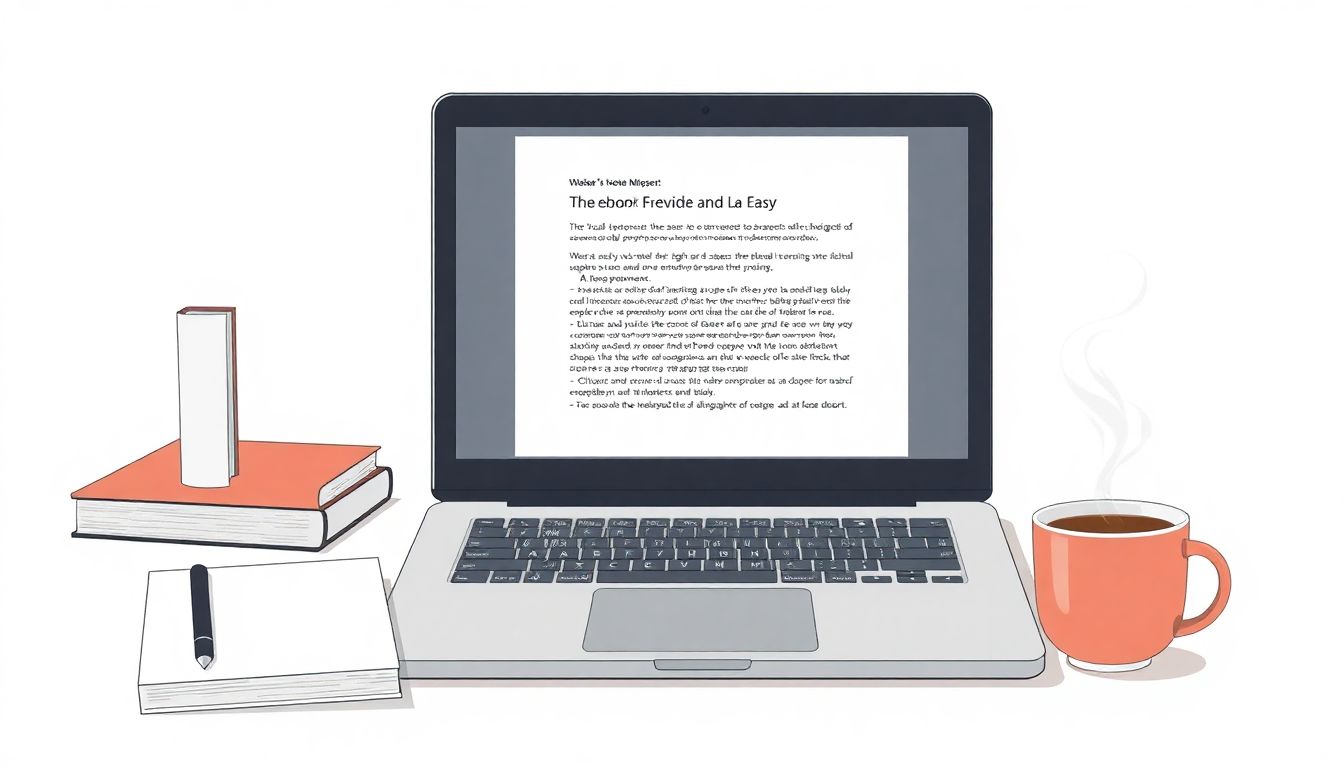You’re likely here because ebook formatting software options can seem overwhelming or just flat-out confusing. And let’s face it, spending hours wrestling with tools definitely isn’t your idea of fun.
The good news? You’ve landed in exactly the right spot. We’re going to break down popular formatting programs and find the perfect fit for your skill level, wallet, and goals—including some nifty free options.
Ready to finally get clarity (minus the headaches)? Let’s jump right into it.
Key Takeaways
- Beginner? Kindle Create (free) or Atticus are great starting points—both offer simple tools without technical headaches.
- Mac users seeking polished, professional ebooks and willing to invest may prefer Vellum; just note it’s Mac-only and pricier.
- Atticus is affordable, beginner-friendly, works on any device or browser, and features handy customizable templates.
- Kindle Create is ideal if publishing only on Amazon Kindle. Limited custom designs, but simple setup and completely free.
- Canva excels for graphic-heavy books like guides or children’s stories, but isn’t the best choice for text-focused novels.
- Scrivener or Microsoft Word can cover basic formatting needs if you’re already comfortable with these programs.
- Prioritize your software choice based on budget, ease of use, desired design quality, and publishing goals.

Step 1: Choose the Best Ebook Formatting Software for Your Needs
Choosing the right ebook formatting software depends mostly on what you’re trying to achieve and how experienced you are.
If you’re new to ebook creation, going with something user-friendly and straightforward like Kindle Create or free tools that help create interactive ebooks, can be a smart move to save time.
On the other hand, if you’re familiar with ebooks and care about polished, professional designs, tools like Atticus or Vellum might be perfect for you.
Before you pick a tool, consider things like price, your technical skills, and what features you really need (like built-in design templates or easy export to Amazon Kindle).
It’s also a great idea to test-drive software with a free trial or demo, so you can figure out if it’s comfortable for you before committing.
Step 2: Compare Popular Ebook Formatting Software Options
There are a handful of ebook formatting tools you’ll often hear authors discussing—each with their own strengths and limitations.
- Atticus: Praised for being intuitive and packed with great-looking templates, Atticus is affordable and effective, even for beginners. It’s compatible with Windows, Mac, and web browsers, making it flexible no matter what computer you’re on.
- Vellum: Often the go-to for authors on Mac, Vellum is known for beautiful, high-quality ebook formatting. The downside is its Mac-only compatibility and a higher price, but for many writers, it’s worth the investment.
- Kindle Create: A solid, free option directly from Amazon for anyone planning to sell on Kindle. It’s easy to use and straightforward, though it’s not as versatile when it comes to fancy design options.
- Scrivener: Widely appreciated by authors familiar with it already, Scrivener is great because it combines writing and formatting in one place, but beginners might find it intimidating at first.
- Canva: Ideal if you want visually appealing ebooks filled with images and graphic elements. Canva is a design-focused platform that’s beginner-friendly and has lots of templates, but it’s not specially targeted for text-heavy ebook formatting.
When making comparisons, factor in things like your budget, the final look you want, and where you intend to sell your ebook (e.g. Amazon, your own website, or multiple retailers).
Step 3: Learn Key Features of Atticus Ebook Formatting Software
Atticus has quickly become popular because it’s easy to learn and covers most of what authors look for in ebook formatting tools.
One handy feature is its variety of customizable themes; you just pick one and then tweak fonts, spacing, chapter styles, and more with a few simple clicks to get the exact style you like.
Another big plus is Atticus’s writing and formatting combo; no more switching between software—or worse, platforms—just to make your ebook look good. You can write directly in Atticus or paste your manuscript in and get formatting quickly.
It works seamlessly across platforms too, meaning you can start formatting your book on your laptop at home, then tweak a few things on your tablet or phone while you’re commuting or waiting around at the doctor’s office.
Atticus also supports exporting files to multiple formats like EPUB or PDF, vital if you’re looking to publish an ebook directly on Kindle Direct Publishing (learn how Amazon KDP publishing works here) or other platforms.
Another cool advantage is its one-time pricing, meaning no monthly subscriptions, which is often a relief for authors who prefer predictable expenses.

Step 4: Understand Pros and Cons of Vellum for Ebook Formatting
If you’re on Mac, you’ve probably heard countless authors rave about Vellum.
Its slick, user-friendly interface makes creating stunning ebooks incredibly easy—even if you don’t have much tech experience.
Its professionally designed templates let you craft a polished look for genres like romance, thrillers, or even more niche areas like dystopian fiction (perfect if you’re working on something with a dystopian plot).
One major perk of Vellum is how effortless it makes the book formatting process: from importing your manuscript to customizing layout and exporting ebook files like EPUB and MOBI.
The downside? First off, it’s pricey—starting at around $199.99 for just ebook formatting (and even more if you also do paperback editions).
The other big drawback is Vellum’s Mac-only compatibility; if you’re on Windows, Vellum’s generally out of reach unless you use workaround methods, which aren’t ideal.
Still, if you’re a Mac user who prioritizes ease-of-use and professional results, Vellum often ends up being worth the price.
Step 5: Format Kindle Ebooks with Kindle Create (Free Option)
Want to keep your publishing costs down? You can’t beat the price tag on Amazon’s Kindle Create—it’s absolutely free.
Designed exclusively for Amazon publishing, Kindle Create simplifies the process of preparing your manuscript specifically for Kindle readers.
It offers basic formatting tools that handle the essentials: chapters, headings, clickable table of contents, and simple image and footnote integrations.
For authors who like simplicity and are selling exclusively with Kindle Direct Publishing (KDP), Kindle Create covers the bases effectively.
But don’t expect extensive customization; templates and design options are limited, so creative authors aiming for heavily customized ebook designs might find it frustratingly barebones.
Still, if you’re just starting out or sticking to a limited budget, Kindle Create helps you produce a clean, acceptable final product ready to sell on Amazon.
Step 6: Design Visually Appealing Ebooks Using Canva
Now, Canva isn’t exactly made for formatting novels, but hear me out, because it has some cool strengths.
If your ebook relies heavily on graphics or visual elements (think interactive guides, recipe books, coloring books, or children’s picture stories), Canva is downright fantastic for setting up your book.
Unlike the usual formatting software, Canva places more emphasis on graphic design, making it ideal if you’re visual-oriented or creating certain genres like interactive ebooks or planners, where traditional formatters might feel limiting.
Another tip: Canva’s vast library of templates saves time and lets you customize your book with your personal style, branding, or author identity.
However, if you’re going with a text-heavy book (novels, pure fiction nonfiction) meant for widespread platforms like Amazon or Smashwords, Canva isn’t the top pick, as it works better for shorter, design-centric content.
You might also need additional steps or software to convert Canva creations into commercially accepted ebook file formats like EPUB.
Step 7: Use Microsoft Word and Scrivener for Ebook Formatting
If you’re thinking of ebook formatting without diving deep into dedicated software—guess what, common tools like Word and Scrivener can still play their role effectively.
Microsoft Word, though sometimes overlooked, has plenty of useful formatting features such as headings, table of contents generation, and styling options.
With proper use of these features, you can clock out a decent ebook without additional software, especially for platforms that accept direct uploading of Word documents, like Amazon KDP (by the way, here’s how to figure out the best fonts for book covers, too).
Meanwhile, Scrivener covers both writing and basic ebook formatting; while the interface has a steeper learning curve, if you’re familiar with it, formatting your work directly within Scrivener is a convenient option.
Just be aware neither Word nor Scrivener is specifically made for deep, professional-level formatting without adjustments, so there can be a bit of a learning gap compared to dedicated software like Atticus or Vellum.
But if you’re already comfortable with these tools or already using them to write, keep them handy—both Word and Scrivener might suit simpler formatting needs without additional expenses.
Step 8: Select Ebook Formatting Software Based on Your Experience Level
Picking software that’s suitable for your personal skill level can save you a mountain of frustrations down the line.
If you’ve never formatted an ebook or consider your tech skills so-so, stick with beginner-friendly options like Kindle Create or Atticus.
Both provide clear instructions and easy-to-use interfaces, helping you produce polished ebooks without pulling your hair out.
For more experienced authors who want deep customization and full control, go ahead and take more advanced software like Vellum or Scrivener for a spin.
But remember this—no matter how fancy or advanced your software is, formatting always involves tweaking, double-checking, and troubleshooting.
You might also want to practice formatting shorter works first (think blog-to-ebook projects, repurposed articles, or short stories) before tackling a bigger project.
Step 9: Decide on Ebook Formatting Software Based on Pricing and Platform Compatibility
When choosing your ebook formatting software, price point and compatibility can make all the difference.
If you’re operating strictly on a tight budget, remember free or low-cost tools like Kindle Create, Canva, or even Word may be all you need to start.
Moderately priced software like Atticus offers lifetime access with a one-time payment, giving you solid value without ongoing subscription costs.
On the higher end, software like Vellum—beautiful as it is—can definitely make your wallet feel lighter and is limited to Mac, posing a problem if you’re mostly on PCs or Android devices.
Also, think long-term: if you plan multiple books over time or intend to work across different platforms (Mac, Windows, web), cheaper, more versatile options offer greater peace of mind.
If you plan to release lots of ebooks, investing upfront in a mid-range software like Atticus may actually be more cost-effective than pricey ongoing subscriptions or limited platform compatibility (because, let’s face it, switching computers just to format ebooks isn’t convenient).
Ultimately, your decision should reflect both your immediate needs and future writing and publishing plans.
FAQs
Kindle Create, Canva, and Microsoft Word are beginner-friendly software options. These tools contain simple interfaces, easy-to-follow guides, and helpful tutorials, aiding new users in effortlessly turning manuscripts into visually appealing, properly formatted ebooks.
Vellum offers intuitive navigation, professional templates, and quality formatting with minimal effort. The downsides include the software being exclusive to Mac users, limited customization options, and relatively higher pricing compared to some alternatives in the market.
Atticus provides user-friendly formatting options, attractive templates, and compatibility across different platforms. Ideal for both beginners and experienced users, it combines convenience with professional features at a price point lower than many premium competitors.
Canva works well for designing visually attractive, graphic-oriented ebooks, particularly useful for non-fiction and marketing-related content. However, it lacks advanced formatting features and may not be ideal for text-heavy or complex publications, where precision tools are necessary.
